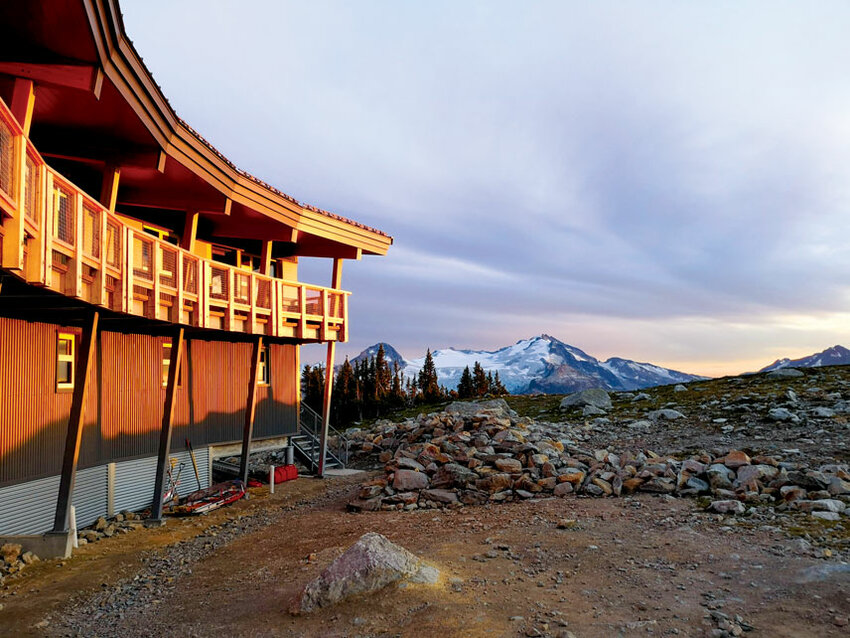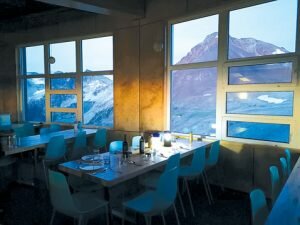 Photos courtesy of Jayson Faulkner.
Photos courtesy of Jayson Faulkner.Just beyond the chairlifts and busy slopes of Whistler Blackcomb Ski Resort lies over 750 square miles of protected land encompassing jagged peaks, deep valleys, glaciers, rivers and lakes. Multi-day backcountry exploration beyond the confines of the ski resort has been limited to the committed few. That changes this season.
The community-built, 38-bed Kees and Claire Hut opened this fall in the heart of some of Whistler’s best backcountry terrain. It’s the first of three huts to be completed along the world-class Spearhead Traverse. First skied in 1964, the traverse follows the peaks and ridges of the Spearhead and Fitzsimmons ranges, forming a 22-mile horseshoe from Whistler to Blackcomb.
A group of representatives from local mountaineering clubs proposed the hut system to the B.C. government in 2012. They aimed to provide high quality, low cost, year-round recreation opportunities in Garibaldi Provincial Park and to reduce environmental impact from that recreation. Concentrating human use to the huts reduces the environmental footprint of backcountry visitors and reduces potential wildlife conflicts. The huts will be roughly evenly spaced along the traverse, offering amazing views and a wide range of access to the surrounding terrain.
The first of the huts took two years to build and involved the help of over 250 volunteers, 70 businesses and hundreds of helicopter flights.
“In this day and age, it seems that this kind of project can only happen with a massive amount of volunteer and community commitment,” said Jayson Faulkner, chair of the Spearhead Huts Committee. Faulkner is especially passionate about the hut and the access it provides to this remote area of world-class mountains.
“Demand for backcountry recreation is bigger than it’s ever been, yet we don’t have a very good system of trails, nor a great system of backcountry infrastructure,” he said. “Infrastructure provides reanimation and rediscovery of the best parts of Whistler – the terrain and the adjacent backcountry. If people don’t have an outdoor experience, they don’t know the value of these places.”
The Kees and Claire Hut is about five miles east of Whistler Peak. The hut sits just shy of 6,500 feet on a south-facing bench above Russet Lake, below the towering Fissile Peak. There are two routes to access the hut by trail – from Whistler Peak along the Musical Bumps or from Whistler Village along the Singing Pass Trail.

The trail from the village starts at the base of the Whistler Gondola. It follows Fitzsimmons Creek and gains over 4,200 feet, reaching the hut in just under nine miles. The easier Musical Bumps route starts from the gondola atop Whistler Peak and undulates along a ridgeline and passes over a trio of summits named Piccolo, Flute and Oboe. Skiers will find plenty of lines along the six-mile route between the peak and the hut, and even more surrounding the hut.
The Kees and Claire Hut was designed for comfort, affordability and energy efficiency, making use of the sun, internal heat sources and heat recovery. The two-story hut has about 2,500 square feet of usable space. The upper level houses a well-stocked kitchen, a large dining space and a comfortable common area with a fireplace. The lower level is divided into six sleeping areas, each with three or four bunkbeds and minimal storage space. There’s also a gear drying room and waste-separating toilets. The hut has LED lighting and a dozen USB ports powered by a propane generator with batteries for solar power storage. There isn’t currently water available on tap, but a water system is planned.
Nearly all the building costs were raised through donations, the largest of which came from the Kees Brenninkmeyer Foundation. The foundation was established in memory of Brenninkmeyer and his partner, Claire Dixon, who were killed when their snow cave collapsed while on a traverse in the Rocky Mountains. Their friends and family thought that a shelter providing safety along the Spearhead Traverse was an appropriate legacy.
To learn more about the Spearhead Huts and to make a reservation at the Kees and Claire Hut visit spearheadhuts.org.